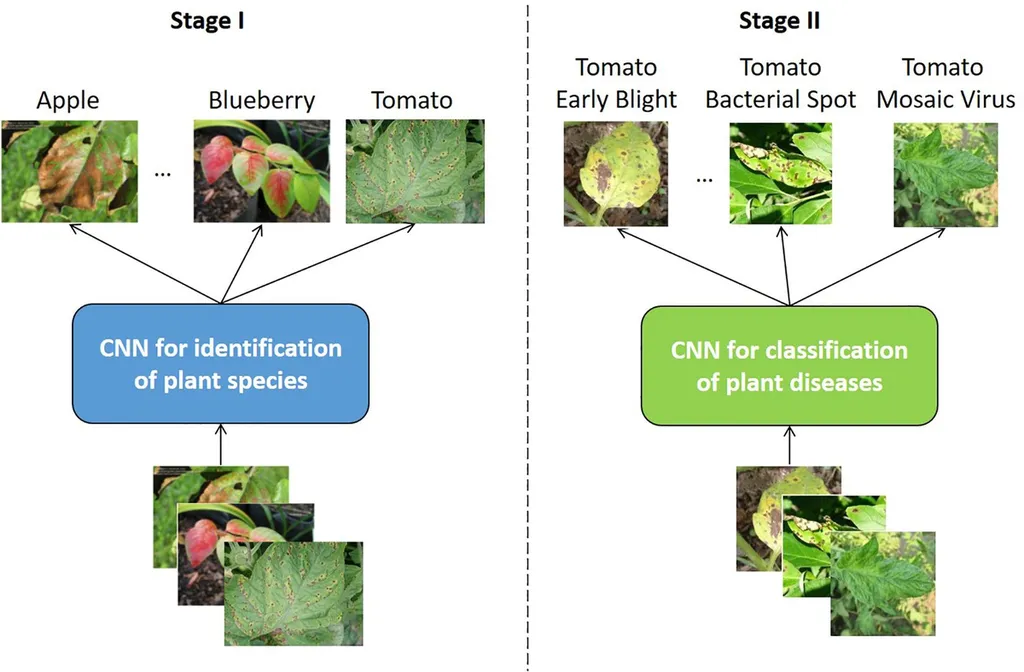In the ever-evolving landscape of precision agriculture, a groundbreaking study has emerged that promises to revolutionize the way we detect and manage tomato diseases. Published in *Frontiers in Plant Science*, the research introduces ToMASD, a lightweight detection model designed to tackle the complex challenges of agricultural environments. The lead author, Jinghuan Hu from the College of Information and Technology at Jilin Agricultural University in Changchun, China, and his team have developed a model that not only enhances detection accuracy but also paves the way for cross-crop generalization, a significant leap forward for the industry.
Tomato diseases have long been a thorn in the side of farmers, causing substantial losses and requiring timely and accurate detection to mitigate damage. Traditional methods often fall short in complex environments where factors like leaf occlusion, varying lesion sizes, and light interference come into play. ToMASD addresses these issues head-on with its innovative architecture. The model integrates multi-scale feature decoupling and an adaptive alignment mechanism, making it adept at handling the intricacies of real-world agricultural settings.
At the heart of ToMASD lies the dual-branch adaptive alignment module (TAAM), which employs a dynamic feature pyramid to achieve cross-scale lesion semantic alignment. This means the model can accurately identify and align disease symptoms across different scales, ensuring nothing is missed. Additionally, the local context-aware gated unit (Faster-GLUDet) uses a spatial attention mechanism to suppress background noise, reducing false positives and enhancing detection reliability. The multi-scale decoupling detection head (MDH) further balances the detection accuracy of small and diffuse lesions, ensuring comprehensive coverage.
The results speak for themselves. On a dataset containing six types of tomato diseases under various weather conditions, ToMASD achieved an impressive average precision of 84.3%, outperforming thirteen mainstream models by a significant margin. “This model not only improves detection accuracy but also reduces computational load to just 7.1 GFLOPs, making it highly efficient and suitable for edge deployment,” explains Hu. The implications for the agriculture sector are profound, as this efficiency translates to cost savings and faster, more reliable disease management.
One of the most exciting aspects of this research is its potential for cross-crop generalization. Through the introduction of a transfer learning paradigm, the pre-trained weights of the tomato disease detection model can be transferred to other crops like common beans and potatoes. By overcoming the domain shift problem with domain adaptation layers and adversarial feature decoupling strategies, the model achieves an average precision of 92.7% on target crop test sets. This adaptability is a game-changer for farmers, as it allows for a more universal approach to disease monitoring across different crops.
The commercial impact of this research cannot be overstated. With false detection rates controlled at 6.3% in foggy conditions and 9.8% in strong light, ToMASD offers a robust solution for real-world agricultural environments. The ability to deploy this model at the edge means farmers can access high-precision disease monitoring without the need for extensive computational resources. This not only enhances productivity but also reduces the environmental footprint of agriculture by minimizing the use of pesticides and other interventions.
Looking ahead, the success of ToMASD sets a new benchmark for agricultural disease monitoring systems. Its dual breakthroughs in high-precision detection and cross-crop generalization ability provide a blueprint for future developments in the field. As the agriculture sector continues to embrace technological advancements, models like ToMASD will play a pivotal role in shaping a more sustainable and efficient future. The research, led by Jinghuan Hu and published in *Frontiers in Plant Science*, marks a significant milestone in the ongoing quest to harness the power of artificial intelligence for the betterment of agriculture.

